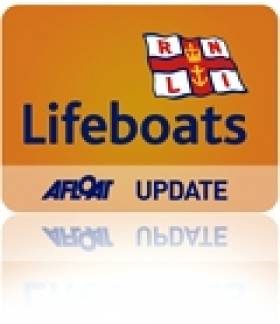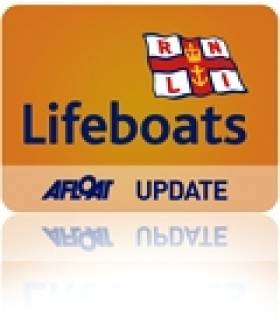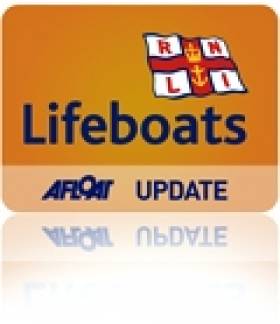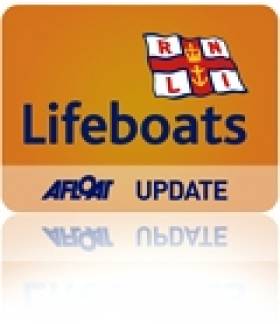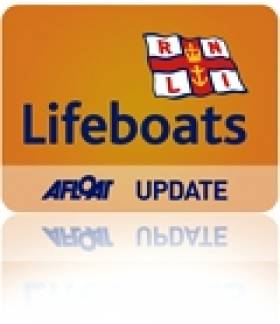Displaying items by tag: Bundoran
Bundoran Lifeboat Crew To Push The Boat Out This Saturday
#RNLI - Bundoran RNLI's annual boat push will take place this Saturday 7 September as the volunteer crew once again embark on the challenge of raising funds for the lifeboat station, which is entering its 40th year of existence.
The boat push will start outside the ambulance base on the Donegal Road in Ballyshannon at noon and members of the lifeboat crew will have buckets with them on the route for people to make a donation.
The route will take them through Ballyshannon, Finner and into Bundoran, finishing at the lifeboat station at Bundoran Pier, covering a distance of almost 10km in four to five hours.
The fundraising drive is just one of the events which helps to run Bundoran RNLI and keep the Atlantic 85 lifeboat William Henry Liddington maintained and ready to go at a moment’s notice.
The volunteer crew counts on the generous support of the public to ensure that the RNLI can continue to provide all year search and rescue coverage and we hope to get lots of support on Saturday.
"The boat push has now become an annual fixture in Bundoran RNLI's fundraising calendar and is something the volunteer crew at the station look forward to each year," said Bundoran RNLI volunteer lifeboat press officer Shane Smyth.
"Not only does it give us a chance to raise much needed funds to continue to run this voluntary service, it also gives us a chance to meet our supporters from the area who continually donate to us despite the tough financial times we find ourselves in."
Bundoran RNLI Lifeboat Launched to RIB with Engine Failure
#rnli – On Sunday evening (4th August 2013), Bundoran RNLI Lifeboat was launched to a rib which suffered engine failure off Inishmurray island.
The rib with 2 people on board suffered engine failure and made contact with another vessel who in turn called out Bundoran RNLI Lifeboat for assistance. The lifeboat paged at 18.57 launched in 4 minutes and headed directly for the casualty vessel, arriving on scene around 20 minutes later.
The Sligo based helicopter Rescue 118 offered assistance by releasing a smoke signal to direct the lifeboat to the rib. On reaching the rib, one of the volunteer crew of Bundoran RNLI transferred to it and assisted the the occupants onto the lifeboat and remained on board to assist with the towing of the vessel to Mullaghmore Harbour.
The lifeboat then completed the tow and returned to base.
#RNLI - Enniskillen RNLI will host the revived Castle Island charity swim and family fun morning in Enniskillen, Co Fermanagh on Sunday 11 August.
The swim traditionally took place each year with the support of the Blake family.
And Enniskillen RNLI have hailed as a "great honour" the opportunity for its local volunteer crew to revive the swim in association with sponsors Blakes the Hollow, Western Cars and The Print Factory.
The 750m swim on Lough Erne is open to swimmers of all ages either individually or in small groups such as youth clubs, sports clubs or simply groups of friends.
Enniskillen RNLI says the emphasis for this swim is for everyone to have fun and for that reason, if required, novice swimmers may complete the swim in a well-fitted lifejacket or buoyancy aid but must be confident that they can complete the distance.
Lifeboat crew not swimming themselves will also be present on the day to provide safety cover for the event.
Registration for the swim will take place at 12 noon on the day, followed by a short safety briefing. Sponsorship forms are available by email or can be collected at The Wig & Crown, Blakes the Hollow and Western Cars. For further information contact Adrian at 07974 730456.
In other news, RTÉ Radio 1’s The Business will broadcast live from Bundoran RNLI lifeboat station this Saturday morning 3 August.
The focus of the show will be on the business of Bundoran being a seaside resort - a reputation the Donegal town has enjoyed for more than two centuries.
Speaking ahead of his visit, programme host George Lee said: "I'm really looking forward to broadcasting from Bundoran, particularly on a bank holiday weekend. I'm hoping to experience lots of surfing, slots machines and ice-creams.
"On the show we'll be looking back at the heyday of the dancehalls, we'll be joined by Bundoran regular Ramona Nicholas from Dragon's Den, we'll be speaking to two men making money from oil exploration and lots, lots more."
The Business is broadcast Saturday morning at 10am on RTÉ Radio 1.
Bundoran RNLI Deals With Two Callouts in One Mission
The volunteer crew of Bundoran RNLI Lifeboat responded to two callouts in one mission last night (Saturday 13 July).
Just after 9.50pm the crew were tasked by Malin Head Coast Guard to a kayaker reported to be in difficulty off St John's Point. Within 4 minutes the Bundoran lifeboat had launched and made its way across Donegal Bay as the sun was setting, to where the kayaker had been spotted by a person on the shore. Pulling up alongside the kayaker the crew discovered the gentleman having a leisurely evening fishing and that there were no problems. This incident was then classed as a "false alarm with good intent" and the crew prepared to make their way back to Bundoran.
As they were en-route back to Bundoran and darkness was beginning to fall, a mayday call was heard over emergency channel 16. Around the same time, the lifeboat crew spotted what they thought was a white emergency flare in the direction of Mullaghmore Head and advised the Coast Guard who then tasked them to the scene to check it out. Arriving on the scene approximately 20 minutes later the crew found no sign of anybody in trouble – a member of the shore crew checked the area on land. The crew were directed to remain on scene until the Rescue 118 Search & Rescue helicopter from Sligo conducted an aerial search after which they were stood down and returned to station around 11.20pm.
Volunteer RNLI lifeboat helm for Bundoran Iarla Carty said 'fortunately the services of the lifeboat were not required on these 2 occasions however we always advise people to call 999 or 112 and ask for the Coast Guard if they think they see someone in trouble at sea. We would always rather launch and check things out to make sure everything is ok – we are mindful in these good weather conditions that more and more people will be using the water and following the news of all the tragedies during the week we would encourage water users to be extra vigilant but to enjoy themselves at the same time.'
#Surfing - Two national broadcasters will base themselves in Bundoran this week ahead of the Sea Sessions Surf Music Festival at the weekend.
Today FM’s KC Show will broadcast live from the Bundoran RNLI Lifeboat Station tomorrow 19 June and Thursday 20 June, while 2FM will broadcast from the Sea Sessions from Friday 21 to Sunday 23 June, giving the seaside town unprecedented national media coverage for five days.
As part of a recent Discover Ireland promotion on Today FM, listeners were asked where to send the various shows to on their holidays. Listeners to the KC Show had a choice of sending him to Dingle or Donegal and following thousands of votes, Donegal came out on top.
One of the locations suggested was Bundoran, and the RNLI Lifeboat station at the pier was chosen as the home for the KC Show for two daily broadcasts this week complete with live musical guests Walking With Cars and new Irish act Daithi.
No sooner will Today FM have packed up than the 2FM Roadcaster will be rolling into the Main Beach car park and preparing to broadcast from the Sea Sessions on Friday, Saturday and Sunday.
The national state broadcaster will give the festival unprecedented coverage with over 20 hours scheduled live from the beachfront. Jenny Greene, Cormac Battle, Ruth Scott and Paddy McKenna will all host their shows live across the weekend.
Bundoran tourism officer Shane Smyth commented: "I am thrilled that not one but two national broadcasters will be in town this week. It will be a welcome boost to the ongoing promotion of Bundoran as a destination.
"Speaking as Bundoran RNLI volunteer lifeboat press officer also, I’m obviously delighted that the RNLI will benefit from two days of national coverage and I know that KC and his team are keen to find out more about the lifeboat service here in Bundoran."
Smyth added: "The guys from 2FM had a great time when they were here a few weeks ago and we look forward to welcoming them again over Sea Sessions weekend. Last time they were here they brought scorching sunshine with them – let’s hope they do the same again!”
Sea Sessions is Ireland's "biggest and best" surfing and music festival and returns for its sixth successive year in 2013. Based in Bundoran, the festival also includes surf tour events in Lahinch, Co Clare and nearby Sligo.
#rnli – Bundoran RNLI were tasked to assist in the search for a child feared to be missing in the water at Rossnowlagh Beach on Sunday afternoon (9th June 2013).
The 6 year old child was reported missing following a 999 call to Malin Head Coast Guard who tasked Bundoran RNLI, the Rescue 118 Coast Guard Helicopter and The Killybegs Coast Guard Boat to search for the boy who was reportedly last seen near the water at around 4pm.
The Bundoran Lifeboat, paged at 4.15pm, arrived on scene at 4.30pm and commenced a search pattern in conjunction with the other rescue agencies and were also assisted by a number of local boats in the area and up to 5 jet-skis.
On the crowded beach, shore crew from Bundoran also helped in the search. As it continued, another call was received to Malin Head regarding a second child (8 years old) who had gone missing not far from the Sandhouse Hotel but was located soon after.
At around 4.50pm, almost an hour after the initial report, the child was found by a family member and the search was called off.
Volunteer Helm for the RNLI Lifeboat Iarla Carty said 'once again we had another happy ending to a callout and another example of rescue agencies working together for a positive resolution - we would encourage parents to be vigilant with their children around the water, particularly when the weather is so good'.
Bundoran Lifeboat Called to Aid Swimmers
#rnli – Bundoran RNLI Lifeboat were tasked to the aid of two young swimmers believed to be in trouble at Main Beach, Bundoran.
The alarm was raised by one of the lifeboat crew who happened to be at the beach and called the Coast Guard at Malin Head who immediately tasked the lifeboat. 6 minutes later the lifeboat made it to the scene to find the 2 young girls from County Leitrim had made it safely to the shore. Members of the Bundoran RNLI shore crew then treated the 2 girls for some cuts received during the incident.
Helming the lifeboat for Bundoran RNLI was Daimon Fergus who said 'we were happy to be able to assist the two girls in this instance. With the good weather, a lot more people are venturing into the water which is understandable but we would always advise bathers to keep water safety foremost in their mind. Watch out for tides and currents, never swim alone, always swim parallel to the shore and don't swim out of your depth'.
Tyrone Team Up at Bundoran RNLI Lifeboat Soapbox Race
#rnli – A motorsport team from Dungannon in County Tyrone has claimed the Bundoran Lifeboat Soapbox Race perpetual cup following an exciting end to the second annual fundraising event which saw a crowd of 2,500 spectators gather on Astoria Hill in Bundoran on Sunday (2nd June 2013). The winner of the ball race was also from Tyrone with the event itself being part of Discover Bundoran's "Big Weekend".
21 year old driver Stewart McClean representing McClean Motorsport got through his heats with ease beating off stiff competition from 25 other soapboxes who were battling it out for the cup, the medals, the bragging rights and with thanks to refreshment partners Mountain Dew Energy, 2 VIP tickets for Sea Sessions Surf Music Festival. The first race of the day was started by newly crowned 'Belle of Bundoran' Rio Carlin Rosanio. Soapbox cars arrived from all over the area and the country to take part in the event which was a fundraiser for the volunteer crew of the Bundoran RNLI Lifeboat with a crowd of almost 2500 people packing onto the Astoria Hill to watch the thrills, spills and crashes from some very creative soapbox cars. McClean Motorsport's entry narrowly beat rival local competitors Good Time Charlies to clinch the title, as the rain started to fall, around 3.45.
Event organiser Cormac McGurren said 'we were thrilled that there was such a large turnout again to support the soapbox race and glad that the light rain which fell didn't put people off staying until the very end. While we are sad to see the cup leaving Bundoran this year, we hope that it might encourage more entries from Northern Ireland next year while giving locals in Bundoran a hunger to win it back for the town'. He also paid tribute to the volunteer lifeboat crew who helped out on the day 'without the teamwork and continued commitment of our volunteer crew to help out with the very important job of fundraising, the whole day wouldn't have happened and on behalf of the organising committee I would like thank them all for their help'.
Amongst the other events on the day was the Huku Boards longboard skate competition, again in its second year. Skaters from all over the country took part and showed off some intricate moves as they took full advantage of the Astoria Road course. Special mention is given to the youngest competitor Aaron Drennan from Dunboyne in County Meath who at just 10 years old proved his worth against the older skaters and won an award for "Grom of the Year".
The much anticipated ball race happened directly after the soapbox race as 1100 balls were dropped out of a tip truck and rolled down the hill. The lucky number that went through the funnel at the end was 565 and belonged to Mary Collins from Castlederg who had just bought her ball that afternoon.
#rnli – The Bundoran RNLI Lifeboat was tasked to Mullaghmore, County Sligo yesterday to assist in the search for two divers feared to have gone missing from a dive.
Launching within 4 minutes of being tasked by Malin Head Coast Guard, the volunteer crew of the Bundoran RNLI lifeboat made their way to Mullaghmore to assist the Rescue 118 helicopter and the dive boat which had been unable to make contact with the two divers.
An initial call had been made to the Coast Guard by passers-by who had seen the two divers in trouble.
As the lifeboat approached the scene they were stood down as the divers had been located by their dive boat, outside of the initial dive area, due to severe currents in the area.
Head Helm for Bundoran RNLI Lifeboat Brian Gillespie said 'we are happy that this was a positive outcome – had it not been for the quick thinking of the member of the public who called the Coast Guard, it may have been a different story. We would always advise anyone who thinks they see someone in trouble on the coast, even if they are unsure, to call 999 and ask for the Coast Guard. We would much rather be called out to make sure everything is ok than have a possible incident go unreported'.
Station To Station Challenge Raises More Than €2,000 For RNLI
#RNLI - Two men who embarked on the first RNLI Station to Station challenge between Bundoran and Arranmore last Saturday (6 April) completed the job in just under 12 hours - raising over €2,000 for both lifeboat stations in the process.
As per their plan reported previously on Afloat.ie, Niall Clancy and James McIntyre both set off from Bundoran Lifeboat Station just after 6am on Saturday morning – Clancy running and McIntyre cycling.
Clancy's route took him through Bundoran, Ballyshannon, Donegal town, Mountcharles, Frosses, Glenties, Gweebarra Bridge, Lettermacaward, Dungloe, Burtonport and finally Arranmore Island via a treadmill on the ferry!
He was joined on various legs of the journey by members of the Tir Chonaill Athletic Club who kept his spirits up on the 100km journey from station to station.
Meanwhile, McIntyre and his team from Mullaghmore Triathlon Club and Donegal Bay Cycling Club took off at the same time cycling as far as Lough Eske, where James then made the lonesome journey himself across the Bluestack Mountains, constantly keeping organisers informed of his progress via text message.
Down into Glenties and from there by bike to Portnoo where, with Bundoran RNLI crewman Killian O’Kelly, he kayaked the remaining 22km to Arranmore Island, where both he and Clancy were greeted by the lifeboat crew and the Arranmore Pipe Band.
Speaking on completion of the challenge at Arranmore RNLI Lifeboat Station, Clancy said: "It’s been a long but great day. The weather conditions couldn’t have been any better for both myself and James – though it was very cold this morning leaving Bundoran!
"I’m looking forward to a few weeks off training before I get back into it for the Athlone Half Ironman in August."
McIntyre added: "We’d both like to express our gratitude to everyone who supported us ahead of the challenge and today – particularly those who sponsored us and those who ran and cycled with us today, our support teams, our chefs, the RNLI crews and sponsors Ormston’s Mace Ballyshannon and All Sports Donegal Town."
Shane Smith, volunteer lifeboat press officer for Bundoran RNLI, said: "We are thrilled at the success of the challenge and delighted that over €2,000 has been raised for both stations.
"We are indebted to James and Niall for their selfless support of our charity and would like to thank them sincerely on behalf of both crews."
Elsewhere, a Wexford family who organised a sponsored swim in memory of a loved one and former volunteer have raised a whopping €5,000 for Kilmore Quay RNLI.
The Hayes family presented the cheque to the RNLI at Kilmore Quay lifeboat station recently, funded by a sponsored swim on St Stephen’s Day organised by the family in memory of the late Paddy Hayes, who was a volunteer with the lifeboat.



























